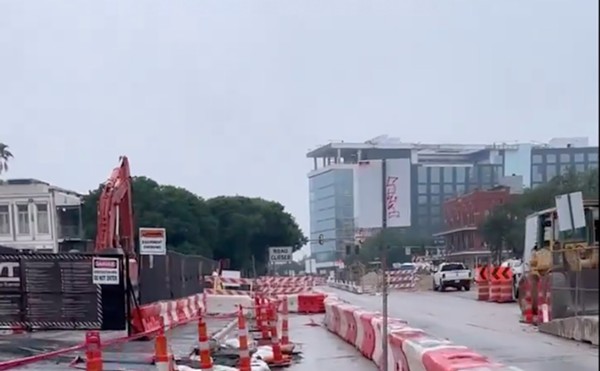Police barricade
If that Roman who said that things that are hard to live through are “sweet to remember” is to be believed, these most surgical of days at the San Antonio Police Department will be recalled with many perfume-scented sighs in the coming years.
It’s been more than a month since Police Chief Bill McManus and other City leaders authorized the release of a veritable catalog of use-of-force-related policy-change recommendations submitted to McManus by the nonprofit police-practices organization, Police Executive Research Forum.
While McManus quickly committed to more than 100 of the 141 recommendations, a shroud of skepticism clouds the remaining reforms. How would the Chief handle the more contentious items that appear to put him on a crash course with the police union?
Though the San Antonio Police Officer’s Association’s prez hasn’t responded to Queque’s request for a heart-to-heart, the Chief downplayed any potential union rumble in a recent Mashup. (See “Chief concerns & PERFormance wisdom,” July 16, 2008.)
While McManus and his PERFies say they are willing to meet community activists on more neutral turf than initially suggested (SAPD Internal Affairs’ shredding room), or this week’s Fredericksburg Road police substation gathering spot, members of the city’s human- and civil-rights communities are hesitant to sign off on the composition or authority structure of the three committees McManus has assembled to steer the department toward adoption of another few dozen reforms.
McManus’s team has vowed there will be more “citizens” serving on the committees than sworn officers, though each will have a team “leader” pinned by the brass. Former City Councilmember Mario Salas, heading the San Antonio Human and Civil Rights Coalition’s response to PERF’s findings, said he is on the lookout for “Trojan horses.” “I just don’t want to see these committees stacked with people who have secret relationships with people who really have set agendas against what we’re trying to accomplish here,” he said at a PERF meeting with McManus last week.
The reforms — such as those that would make it easier for the public to file complaints against officers — can expect pushback from the police union, Salas said. But the City may do some of their own pushing come January, when new negotiations are expected to begin on the union’s contract.
License to kill
Nearly buried in all the feel-good projections about SA’s fiscal future at last week’s Council meeting was the announcement from City Manager Sheryl Sculley that local park and airport police officers had overwhelmingly approved the addendum to their Meet and Confer Agreement with the City.
To anyone who observed the negotiation process at close range, the vote was hardly a surprise. As the Current reported last week (“No Day in the Park”), park-police labor negotiator Tommy Calvert resigned on August 11, saying the SAPPOA leadership had shut him out of the process and had brokered a deal that left the park police with no rights. Calvert said many rank-and-file park officers had privately complained to him about the deal — which places park and airport police under the “supervision, span of control and/or administration” of Police Chief McManus, while relinquishing any rights to equal pay — but he also predicted that the agreement would pass easily.
Calvert and other critics of the deal worried that many park officers had not read the fine print of the agreement or had been convinced by their leadership that the park police faced no threat of termination. Along those lines, they received verbal assurances from McManus at an August 13 public meeting attended by councilmembers Delicia Herrera, John Clamp, Justin Rodriguez, and Phil Cortez. That night, park and airport police officers approved the addendum with an unequivocal 82-percent majority (118-26).
Blinded by the light
The Queque feels not unlike her favorite childhood storybook protagonist, the Poky Little Puppy, in her pursuit of the Clear Channel digital-billboard lightning strikes.
Zap! The Federal Highway Administration issued a September ’07 memo saying that “changeable electronic variable message signs” do not violate federal rules prohibiting “intermittent,” “flashing,” or “moving” lights on billboards along federally funded highways.
Zing! SA’s City Council approves a pilot program December ’07 that awards 12 of 15 digital-billboard licenses to Clear Channel.
Thwap! In February ’08 the Texas Transportation Commission codifies language that says Tejas like digital billboards, too, and cities can have as many as they like, more or less.
Zzzzp! Our Electrical Supervisory Board reviews the final three Clear Channel apps in August ’08, giving SA at least seven blinky-bright signs along our officially designated Scenic Corridors, where, theoretically, billboards are banned.
(How? Where? Pick up the Current next week.)
That feat in and of itself is worth the multiple open-records requests being copied, collated, and billed to our account here and abroad, but fascinating little baubles keep getting in the way of our hardnosed pursuit. Like rumors that Clear Channel Oudoor Prez Blake Custer used to work with City Manager Sheryl Sculley in Phoenix before he led the company’s efforts to brighten Arizona’s byways with digital signage and eventually moved to SA.
“He was under Sheryl Sculley in Phoenix, that’s true,” said Clear Channel VP Tim Anderson on behalf of Custer, who was on vacation the last fortnight. No further clarification has been forthcoming from Clear Channel, and Sculley’s office has rebuffed multiple entreaties, passing along only a terse, third-party, “I do not have a confirmation for you.” Which of course isn’t a denial, per se. The Queque seeks clarification.
Another strawberry in the field, ripe for sniffing: In one of the final votes of his brief City Council career, District 9 rep and current Commissioners Court candidate Kevin Wolff voted to approve the digital-billboard pilot program. The betrayal of your Scenic byways was unanimous, save the absent Cortez, but Wolff is lonesome in reaping the rewards: His campaign coffers are $8,000 richer thanks to donations from the Mays (Mark and Randall, CEO and CFO, respectively, of Clear Channel Outdoor), Clear Channel Outdoor lobbying reps Martin & Drought, and Bill Kaufman, who lobbies for Clear Channel Airport. Of course, Clear Channel’s not in immediate dire need at the County, or really any SA-related, level: In addition to their billboard deal, they already have a 10-year advertising contract sewn up for the the Alamodome, the airport, and the Henry B. Gonzalez Convention Center.
Kevin Wolff’s lonesome but not alone: In May 2007, Clear Channel contributed $40,000 to the Foundation for the Future PAC, which lobbied for last May’s $500-million bond election. How could the City say no to friends like that? •
Subject: digital billboards in Phoenix & Blake Custer
From: Elaine Wolff, [email protected]
To: Di Galvan, [email protected]
Mon, Aug 18, 2008 at 11:11am
Good morning, Di.
Thank you for calling back last week. This is to follow up on the comment you relayed from the City Manager re: the digital billboards in Phoenix, that “all that took place after she left.”
As I mentioned on the phone, a couple of documents I’ve found indicate that at least part of the conversation was taking place while she was in the City Manager’s office there, and while Blake Custer was working for Clear Channel Outdoors in Phoenix.
• A November 2000 City Council Report to Asst. City Mgr. Sheryl Sculley from Community and Economic Devpt Director Patrick Grady titled Downtown Electronic Billboards discusses regulations relating to downtown signs with electronic message display and animation.
• In April 2003 minutes from the `Arizona Senate` Committee on Commerce, Blake Custer, VP of Real Estate, Clear Channel, discussing two electronic billboards, on I-10 and I-17, said “he was the individual who pursued the permit process through the City of Phoenix and ADOT ... He said the signs were existing, but the electronic message displays were new.”
I would be grateful if the City Manager could speak with me by phone today to explain the background of digital billboards in Phoenix -- my understanding from talking to several different parties is that Clear Channel’s efforts originated there.
Also, Tim Anderson at Clear Channel, in response to a question from me, said that “`Blake Custer` was under Sheryl Sculley in Phoenix, that’s true,” but couldn’t provide any further details. (I do have a call into Mr. Custer, but he was on vacation last week.) Could the City Manager confirm (or not) that, and provide details -- i.e. for what period of time, his job description, and duties, and whether they had any relation to signage, etc?
Thanks again for your assistance. As I mentioned last week, my deadline is tomorrow morning at 10am.
Elaine W.
From: Di Galvan
To: Elaine Wolff
Mon, Aug 18, 2008, 4:57pm
Elaine:
The Manager’s response is that she was not involved.
Di
From: Elaine Wolff
To: Di Galvan
Mon, Aug 18, 2008, 5:00pm
Thanks, Di.
Can she at least confirm or deny that Blake Custer worked under her in the Phoenix City Manager’s office?
Elaine W.
From: Di Galvan [email protected]
To: Elaine Wolff, [email protected]
Tue, Aug 19, 2008, at 6:17am
Elaine, I do not have a confirmation for you.



















